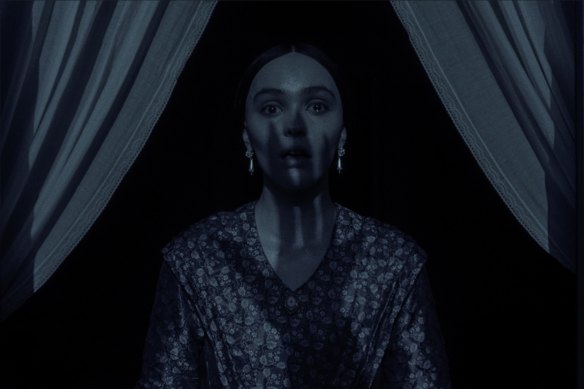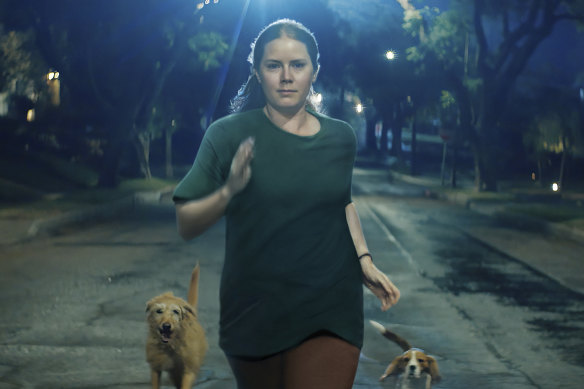
The monster as erotic fetish had actually reached its zenith 40 years earlier, in Walerian Borowczyk’s 1975 oddity, The Beast. Borowczyk, born in Poland in 1923, was an exceptional director who became increasingly fixated on sex, voyeurism and his own conception of female desire. In The Beast, a naive young woman stays in a French chateau, where she has vivid dreams of running through the surrounding forest and being ravished by an ursine assailant. Sumptuously pornographic and widely banned, the film is now regarded as a teratophiliac classic.

Tilda Swinton in the Jim Jarmusch film Only Lovers Left Alive.
Vampires are another kind of Other; creatures of darkness whose overpowering urge to siphon blood from the young and nubile is generally read as a sexual metaphor. Countless films from the silent era onwards show the vampire’s victims experiencing a glorious release as the debonair roue’s teeth pierce her neck, although the vampire trope does allow for surprising variations: the vampire as child’s best friend (Let the Right One In); as world-weary bohemian (Only Lovers Left Alive) or as a 100-year-old virgin who finds chaste love with a schoolgirl (Twilight). One critic described Twilight as “abstinence porn” – which has its own erotic charge, of course. It certainly worked for its teen audience; author Stephanie Meyer’s books sold in the millions, while the subsequent film franchise generated over US$3billion.

Lily-Rose Depp as Ellen Hutter in the new remake of Nosferatu.
This week, a new version of Nosferatu – a remake of the 1922 silent classic, which was based on Bram Stoker’s 1897 novel, Dracula – reaches our screens. Count Orlok, as Dracula was renamed by the original German producers for copyright reasons, is not the suave aristocratic kind of vampire, like Bela Lugosi or Claes Bang. Introduced as a scorching disembodied voice like a Sensurround death rattle, he eventually materialises as a great slimy man – played by an unrecognisable Bill Skarsgard – who seems to be rotting before our very eyes. As such, he proves irresistible.
Director Robert Eggers cleaves to the plot points of F.W. Murnau’s original, but turns the narrative around to be told from Ellen’s point of view. The switch of focus effects a telling change of tone. In the first film, an ailing Ellen senses the approach of “the Master” from Transylvania, as if she were a kind of wireless transmitter picking up his signal, not long before he arrives. It is only after her tragic demise that the men around her realise she lured the vampire to his death, paying the ultimate price for her sacrifice.

Amy Adams in the upcoming film Nightbitch.Credit: AP
In Eggers’ film, Ellen catches Nosferatu’s emanations while still a small girl. Neglected, lonely and intellectually frustrated, she responds to his call with both terror and excitement. That demonic voice, coming from some distant sphere, is terrifying, of course, but is also alive with the possibilities of an exterior world. She thus grows up with dangerous yearnings that make her ill, as such feelings must make any decent Victorian wife. But when she sacrifices herself to him, it is not in a spirit of submission. Having hardened her resolve to save the world, she goes headlong into her own destruction with evident zest.
More monster love, of a kind, is coming in January. Nightbitch, Marielle Heller’s adaptation of Rachel Yoder’s novel in which a harassed mother, played by Amy Adams, finds herself growing abundant body hair. Her husband puzzles over why she comes home from a run covered in mud, but he is easily distracted by her sudden need for sex; her son is happy she now wants to play on the floor.
Neither notices she has the bony beginnings of a tail; Mother herself doesn’t care. On the contrary, she embraces her own monstrousness. In the process, her body – racked by birth, exhausted by domestic labour, while her spirits are deflated by her loss of a sense of independent selfhood – is newly eroticised as she finds pleasure in herself. Every dog has its day, and she is finally having hers.
Loading
What these films do not include is that moment of swooning abandonment, when the heroine can no longer be held responsible for what overtakes her. In Victorian novels, horror films of the ’50s and many strands of the modern romantic boom, women are leached of autonomous desire.
Even Twilight’s Bella is arguably drawn to Edward because, as a natural predator, he is gifted with a supernatural power of attraction. And, of course because he looks like Robert Pattinson: the girl can’t help it.
A new kind of Bella might be more excited by someone with horns and leathery wings. You can just imagine her saying it: yes, that’s my man.
Nosferatu opens in cinemas on January 1.



